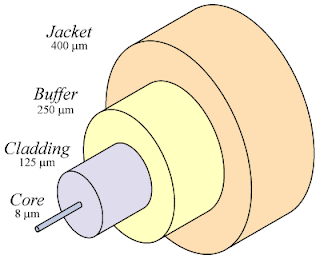DESIGN
OFC made up of 3 layers.
- fibre or core
- cladding
- outer jacket
In practical fibers, the cladding is usually coated with a tough resin buffer layer, which may be further surrounded by a jacket layer, usually plastic. These layers add strength to the fiber but do not contribute to its optical wave guide properties. Rigid fiber assemblies sometimes put light-absorbing ("dark") glass between the fibers, to prevent light that leaks out of one fiber from entering another. This reduces cross-talk between the fibers, or reduces flare in fiber bundle imaging applications.
Because of the Low loss, high bandwidth properties of fiber cable they can be used over greater distances than copper cables, in data networks this can be as much as 2km without the use of repeaters. Their light weight and small size also make them ideal for applications where running copper cables would be impractical, and by using multiplexors one fibre could replace hundreds of copper cables. This is pretty impressive for a tiny glass filament, but the real benefits in the data industry are its immunity to Electro Magnetic Interference (EMI), and the fact that glass is not an electrical conductor. Because fibre is non-conductive, it can be used where electrical isolation is needed, for instance between buildings where copper cables would require cross bonding to eliminate differences in earth potentials. Fibres also pose no threat in dangerous environments such as chemical plants where a spark could trigger an explosion. Last but not least is the security aspect, it is very, very difficult to tap into a fibre cable to read the data signals

